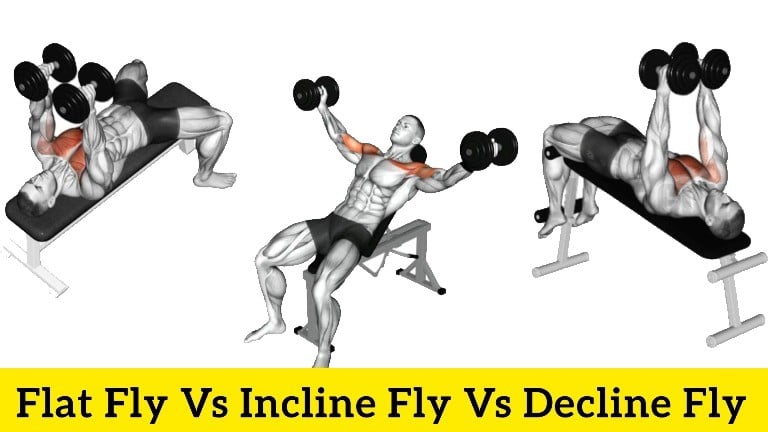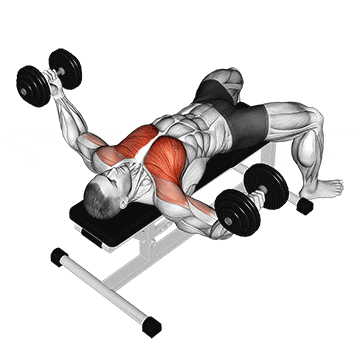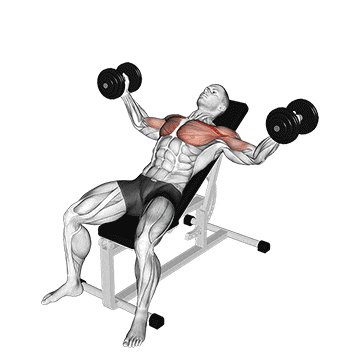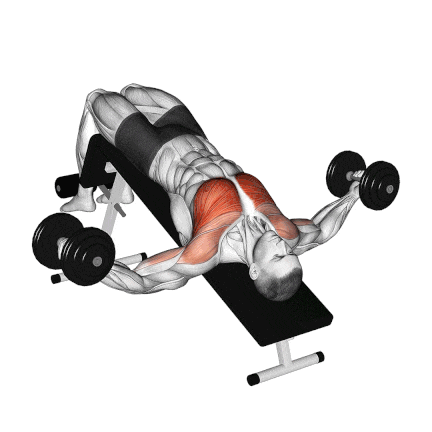Are you looking to build a bigger, stronger chest? If so, chest flyes are a great exercise to add to your workout routine.
With so many options, such as flat chest fly, incline chest fly, and decline chest fly, choosing the right one can be challenging. Each variation has its unique benefits and targets different parts of your chest muscles.
Don’t WORRY
In this blog post, we’ll compare flat, incline and decline chest fly to help you decide which is best for your goals.
We’ll discuss the following:
- What is Chest Fly
- Benefits of each exercise
- How to do them correctly
- How to incorporate chest flyes into your workout routine

- What is Chest Fly
- Which One Is Best: Flat Chest Fly or Incline Fly or Decline Fly
- Flat Chest Fly
- Incline Chest Fly
- Decline Chest Fly
- 1. Flat Chest Fly
- How To Do
- 2. Incline Dumbbell Chest Fly
- How To Do
- 3. Decline Dumbbell Fly
- How To Do
- FAQs
- Which chest fly is best for the lower chest?
- Are incline flys better than normal flys?
- Is decline fly harder than incline fly?
- Conclusion
What is Chest Fly
The chest fly is an isolation exercise that primarily targets the chest muscles. It is considered one of the most effective chest exercises that enhance chest strength, size, and definition.
A chest fly exercise mimics the movement of a bird spreading its wings by moving the arms in an arc motion. This motion allows for a greater range of motion compared to traditional pressing exercises, such as bench press.
At the bottom of the movement, the chest muscles are stretched out fully, which leads to a bigger contraction and more muscle growth.
The chest fly exercises can be performed using dumbbells, cables, or machines.
- Dumbbell Fly provides a greater range of motion and requires more stabilization. They are an excellent choice for building functional strength.
- Cables and machines chest fly provide constant tension throughout the exercise. They also allow for a more controlled and isolated contraction of the chest muscles.
Now that we understand the mechanics behind chest fly exercises let’s explore the specific variations: the flat chest fly, incline fly, and decline fly.
Which One Is Best: Flat Chest Fly or Incline Fly or Decline Fly
So, which type of chest fly is right for you? It depends on your goals and preferences. Each variation targets different areas of the chest and offers unique benefits.
Let’s look at the key aspects of each exercise to help you make an informed decision.
Flat Chest Fly
- The Flat chest fly is the most basic type of chest fly. It requires a flat bench.
- It targets the entire chest and is effective at building overall chest mass.
Incline Chest Fly
- Incline chest fly is done with the bench at an incline of 30–45 degrees.
- It targets the upper chest more than the flat chest fly.
Decline Chest Fly
- Decline chest fly is done with the bench at a decline of 15–30 degrees.
- It targets the lower chest more than the flat chest fly.

1. Flat Chest Fly
The flat dumbbell fly is a bodybuilding favorite and a chest isolation exercise, usually performed after big compound lifts, such as the barbell press and incline bench press.
They are considered the perfect finishing move and a great way to focus on your chest after pressing exercises.
The dumbbell fly utilizes a chest fly movement pattern to isolate the chest muscles, helping them grow better and become stronger.

How To Do
- Lie flat on a bench with your feet firmly planted on the ground.
- Pick a weight that you can control, that’s not too light or heavy — find what’s right for you.
- Hold a dumbbell in each hand with a neutral grip (palms facing each other).
- Slowly lower the dumbbells out to the sides in a wide arc.
- Lower the dumbbells until your arms are parallel to the ground or slightly below and you feel a stretch in your chest. Don’t let your elbows drop too far.
- Use your chest muscles to lift the dumbbells back up to where you started.
2. Incline Dumbbell Chest Fly
If you want to build more thickness, muscle, and strength in your upper chest, add this incline dumbbell chest fly exercise to your chest workout.
Why are incline dumbbell flys so vital? They are the best exercises to help train the chest at various angles and strengthen the upper chest and shoulders.
Incline chest fly can be done with dumbbells, cables, or machines. However, the Inline decline fly exercise is popular among weightlifters and fitness enthusiasts.

How To Do
- Set the bench at about 30-45 degrees inclined; don’t go beyond that, as the stress shifts more to the shoulders.
- Lie on the bench with your feet flat on the floor.
- Lift your arms straight up from your shoulders and the dumbbells directly over your upper chest.
- Slowly lower your arms to your sides until your wrists reach about shoulder level or slightly above.
- Pause at the bottom of the movement.
- Then, slowly bring the dumbbells back up to the starting position
- When you reach the top, don’t let the dumbbells touch. Hold for a second in the contracted position.
3. Decline Dumbbell Fly
Decline dumbbell fly targets the lower chest muscles and gives you a chiseled and defined look.
The lower chest is one of the harder areas to train because of the lack of variations available and the limited range of motion. That’s why it’s so important to incorporate these best dumbbell decline fly exercises into your chest workout routine.
It is performed on a decline bench with a 30 to 45 degrees downward slope.
It involves lying on a decline bench with your head lower than your feet and holding a dumbbell in each hand.

How To Do
- Set a decline bench at a 15-30 degree angle.
- Lie on the bench with your head at the lower end and your feet firmly on the floor.
- Grab a dumbbell in each hand and lie on your back on a decline bench. Hook your feet into the foot pad or roller.
- Extend the dumbbells above your chest. Turn the palms to face each other and the dumbbells directly over your upper chest.
- Slowly lower the dumbbells in a wide arc until your arms parallel the floor.
- Pause briefly, then bring the dumbbells back up to the starting position.
- Use different variations of the Decline dumbbell fly to add variety to your workout routine.
FAQs
Which chest fly is best for the lower chest?
Decline chest fly is best for targeting the lower chest. This exercise is done on a decline bench, which puts the chest muscles at a greater contraction angle. This makes it easier to isolate the lower chest muscles.
Are incline flys better than normal flys?
No, incline flies are not better than normal flies. They are simply different exercises that target different parts of the chest.
- Incline fly targets the upper chest, while the standard fly targets the entire chest.
- Incline fly is a good option if you want to make your upper chest look more full.
- It is a good option if you are looking to build overall chest mass.
Is decline fly harder than incline fly?
Yes, the decline chest fly is typically harder than the incline chest fly. This is because the decline bench puts more emphasis on the lower chest, which is a smaller and weaker muscle group than the upper chest. As a result, lifting weights during a decline in chest flies takes more effort.
Conclusion
Three variations of chest fly exercises target different areas of the chest and help you achieve a well-rounded chest.
The flat chest fly targets the middle and lower portions of the chest, the incline chest fly targets the upper portion of the chest, and the decline chest fly targets the lower portion.
Including all three fly variations in your workout routine will ensure you hit all the right spots on your chest.
References
- Tom Erik Solstad, Vidar Andersen, Matthew Shaw, Erlend Mogstad Hoel, Andreas Vonheim and Atle Hole Saeterbakken: A Comparison of Muscle Activation between Barbell Bench Press and Dumbbell Flyes in Resistance-Trained Males.
- Reiser FC, Lira JLO, Bonfim BMA, Santos Filho SJA, Durante BG, Cardoso JMD, Miotto H, Soares MAA, Bonuzzi GMG, Tavares LD. Electromyography of Dumbbell Fly Exercise Using Different Planes and Labile Surfaces. JEPonline 2017;20(6):31-40

Manish brings over 10 years of hands-on experience in weight lifting and fat loss to fitness coaching. He specializes in gym-based training and has a lot of knowledge about exercise, lifting technique, biomechanics, and more.
Through “Fit Life Regime,” he generously shares the insights he’s gained over a decade in the field. His goal is to equip others with the knowledge to start their own fitness journey.
